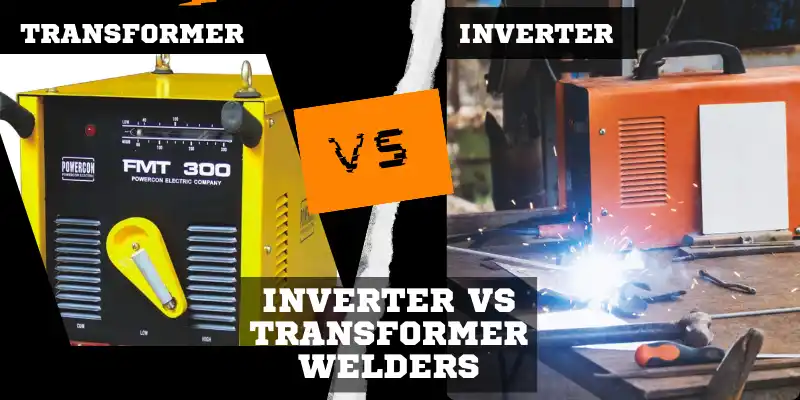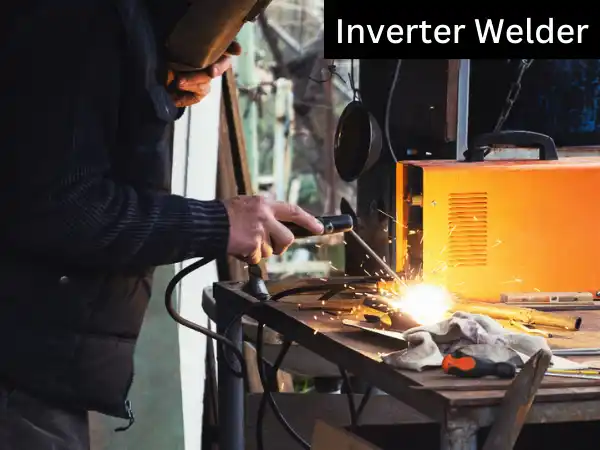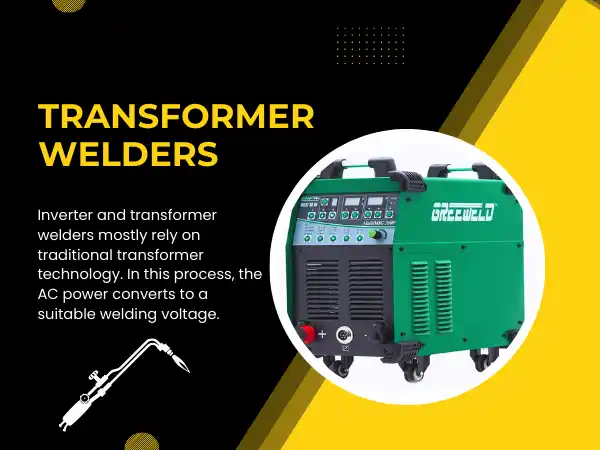Inverter Vs. Transformer Welders – A Detail Guide
Updated: 4 Jan 2024
91
In the world of welding technology, choosing between an inverter and a transformer welder is a pivotal decision that shapes your whole welding process. Each welding technology has its advantages and disadvantages to shape your decision.
The importance of choosing and having one welding process lies in aligning with welding equipment and your specific needs. If you prioritize versatility and precession, go with an inverter welder, but if you favor durability and cost-effectiveness, the right choice would be a transformer welder.
Both of the welding processes are good for almost every welding process. Each has a set of pros and cons that can’t be replaced by one another. After discussing the topic with a welding expert, we now have a detailed guide about inverter welders vs transformer welders. So, let’s get to it.
Inverter Vs. Transformer Welders:

Welding technology has undergone a lot of different advancements over the years, which have revolutionized the whole metal process in most welding fabrication. All these advancements also bring crucial decisions like choosing between two welding types, inverter vs transformer welders.
Choosing between them could be hard sometimes, but if you have what you need and what you are getting, then it will become easy. Below, we define and discuss different aspects of these two welding technologies.
Inverter Welders:

Image by devmaryna on Freepik
The inverter welders are the modern welder’s approach to welding with the latest technology. This welder utilizes advanced electronics, which convert usual AC power to DC. The Conversion then allows the inverter welder to be precise and control the welding arc.
This way of welding is quite popular due to its efficiency and becoming increasingly versatile occasionally. It may be expensive, but trust me, it’s worth its price.
How Does it Work:
It has different working mechanisms depending on its electronic components. It utilizes different high-frequency transmitters to convert the input AC power into DC power. After that, the DC power is transformed back to AC with a high frequency, usually in kHz ranges. In this frequency, the AC powers up the welder to control the welding arc precisely.
Most of the inverter welders can adjust its welding parameters efficiently and rapidly. The whole process of inverter welders involves converting power to its electronic components to achieve optional welding. It has different advantages, which are defined one by one in the article below.
Advantages of Inverter Welders:
Portability and Size:
Portability is also an advantage, especially in welding inverters. The inverter welder is very compact and lightweight, which can be carried anywhere easily compared to traditional transformers, which are bulky and heavy to carry around.
Portability is one of its main characteristics, which allows welders to carry it anywhere in their construction field or for remote repair. Its portable size makes it one of the most suitable inverter welding machines.
Energy Efficiency:
The inverter welders operate at a higher frequency, which results in energy efficiency compared to traditional transformers. This energy efficiency plays an important role in making it power efficient because it uses less power, which affects the overall operating cost.
Its energy efficiency is also important in being environmentally conscious because of its low power usage. The nature of these welders makes them sustainable for practice.
Versatility in Power Input:
Most of the time, welder machines have limitations in their power input, but not inverter welders. It shows great flexibility in handling different power inputs. It can be adapted to almost any power source, like a generator or fluctuating power supply, without affecting its welding performance.
Power usually has bad situations in most welding environments, but when you have an inverter welder, don’t worry because its adaptability suits any diverse situation and working environment conditions.
Cooling
One of the cool things about inverter welders is that they’re equipped with a cooling machine with a cooling fan. During the welding, the investor also produces a lot of heat, and this cooling system reduces all of its operating heat. The cooling system keeps the inner machine cool, which makes it safe from heat damage.
The cooling mechanism reduces almost the overall heat and prevents it from damage, which automatically increases its life span.
Limitation of Inverter Welders:
Cost:
As mentioned above, an inverter welder has numerous advantages, but it’s associated with higher prices than traditional transformer welders. The inverter welder’s advanced technology and advanced electrics contribute to its elevated price.
It is expensive if you need more budget, but most welders find it a beneficial long-term investment.
Complexity:
As mentioned above, it has advanced electronic systems and mechanisms, but it poses a challenge when it comes to repair. Repairing or replacing any of its parts needs and requires specialized knowledge and skills.
Most welders aren’t unaware of this, but it is essential for potential maintenance and further decision-making.
Transformer Welders:

In contrast, Inverter and transformer welders mostly rely on traditional transformer technology. In this process, the AC power converts to a suitable welding voltage. This is older welding technology than inverter welders and has served the industry for many years by offering durability and reliability.
How does it work:
A transformer welder works on the principle of electromagnetic induction. In this case, the welding machine has both the primary and secondary coils of wires that roll around an iron core.
When the current flows in the primary coil, it produces a magnetic field in the iron core, subsequently inducing a current in the secondary coil. Then, the second current produces high voltage, which is required for welding. This results in an electric arc, which is then used for welding.
Advantages of Transformer Welders:
The transformer welders offer different advantages, which are listed below in detail.
Durability:
One of the main advantages of this transformer welder is its durable and robust construction. It offers simplicity in its design, contributing to its lower likelihood of breakdown or malfunction, resulting in a longer lifespan.
It is recommended for most heavy-duty welding, where equipment durability is the main focus. Whenever welding requires durability, a transformer welder is the preferred choice.
Cost Effectiveness:
One of the advantages of the transformer welder is its affordable initial price, which is way lower than that of the inverter welder. The cost-effectiveness of transformer welders makes it a suitable choice for all those welders who have a low budget or prioritize lower upfront costs.
The transformer welder is very simple, and the overall system and process have low complexity, which also contributes to its cost savings.
Reliability:
The transformer welders’ straightforward design enhances their reliability in almost all welding applications. Any welders who choose dependable and consistent performance may need a transformer welder, which may be well suited for most of their other needs.
The reliability of welding machines is found advantageous in most scenarios and where downtime is minimized.
Suitable for Working Environments:
Most welding environments are surrounded by pollution like dust, smoke, different fumes, and other debris, which affect your welding machine and stop them, which affects not only your welder but also your surroundings.
Most of the new welding machines may still go to a halt, but transformer welders may not. It’s suitable for conditions and working environments like this. With a transformer welder, you don’t have to worry about halting; instead, it will keep you occupied almost all day.
Limitations of Transformer Welders:
Size and Weight:
One of the most notable limitations of a transformer welder is its size and weight. Most of the traditional transformers are bulkier, heavier, and more significant as compared to inverter welders. The size and weight can be challenging regarding mobility and limit the transformer welder for any portable work.
Power Efficiency:
Well, transformer welders may be reliable, but when it comes to efficiency, they may be less power-efficient than inverter welders. The energy conversion in all transformer welders leads to high power consumption.
Comparison between Inverter and Transformer:
After understanding both the inverter and transformer, welders understand the characteristics of their welding machines. Below, we have a detailed explanation that will help you decide which welder machine to go with.
Performance and Power Output:
The inverter welder is known to provide better control over the welding arc, which eventually results in better performance, especially in applications where accuracy and finesse are in demand. Its suitable arc also contributes to smoother and cleaner welds.
On the other hand, transformer weld may be robust, exhibiting more variability in arch stability. It sure is reliable, but less than an inverter welder.
Welding Process Supported:
The inverter welder is versatile and is compatible with various welding processes like TIG, MIG, and SMAW. The flexibility of inverter welders allows different welders to adapt to different welding scenarios.
On the other hand, transformer welders can have different welding processes, but it may require manual adjustment and accessory changes to switch and fit those welding types, which require a lot of time.
Use and Control:
When it comes to usage, the inverter welder mostly has a user-friendly screen that features different digital controls, making it easy to use and operate even for beginners. Through these settings and controls, you can choose and select precise settings that will give you better welds.
The transformer welders don’t have any screen to choose your setting form, but it has a straightforward manual adjustment, which you must learn properly to achieve your optimal setting.
Environments:
As discussed above, the environment plays an integral part in any welding. If we have to compare the inverter and transformer welder, then the transformer welder would be the winner here because it can handle any dust and debris and work in any environment. You can start in any environment. It will work with halting once.
On the other hand, the investor doesn’t have the power to withstand any environmental challenges and, most of the time, turns off in conditions like this. The manufacturer is working on making it more durable and strong enough to withstand these conditions.
Maintenance and Longevity:
The maintenance of an inverter welder needs proper and delicate handling, which only then ensures longevity. At the same time, the transformer welders have a robust construction, which is less likely to be broken. It can endure any condition with minimal condition requirements.
Cost Considerations:
Cost is a very important factor, and you must think about it before getting to any welding machines. The cost of an inverter welder is usually high, but it can be a potential long-term energy and efficiency saving. On the other hand, transformer welders are most budget-friendly and cost less than inverter welders. If you have the budget or want precise welds, go for inverter welders, but if you don’t have enough budget and do normal fabrications, consider transformer welders.
Different Welding Areas:
This welding process is different from one another. Each one of them is specialized in its area. Like the invert, they shine in an application where precision and control are required because they give you control of the welding process.
On the other hand, transformer welding is known for its durability and reliability. The transformer welder is recommended for its heavy-duty welding applications, which include different industrial tasks, both small- and large-scale projects.
Mobility:
Mobility is one of the main differences between inverters and transfer welders. If your world involves frequent movement from site to site, you should get an inverter welder because it’s lightweight and easily carried around.
On the other hand, a transformer welder is very heavy and bulky and can’t be moved around easily from one place to another with some external help. It is also hard to set up, so you only have to install it once on a site and remove it when the word is done.
FAQs
What are the disadvantages of inverter welding?
There are a couple of different disadvantages of inverter welding. It’s more expensive than a transformer welder. It can also need a proper technician to fix or replace its parts. It can’t work correctly in humid, dusty, or rough environments.
Are inverter MIG welders any Good?
Yes, inverter MIG welders are excellent, with severe advantages like efficiency and precision. It also consumes less power, which is very good and essential for MIG welders.
Why use an inverter welder?
There are many benefits of using inverter welders, such as their versatility and efficiency in the welding process. It is also suitable for most welding processes like MIG and TIG. It is lightweight, which makes it easy to carry anywhere easily.
Are Inverter Welders Durable?
Yes, inverter welders are durable, but some conditions can affect their durability. Those conditions are dust, dirt, and high moisture environments. Environments like these affect the inverter welder and, most of the time, make it halt and stop working.
What does a transformer do in a welder?
The transformer usually powers the welding machine to convert high-voltage input into low-usage power. It transforms 600 volts in lower AC to 55 amps.
What are the disadvantages of transformer welding machines?
It has a couple of disadvantages, like it uses a lot of power, making it less energy efficient than inverter welders. It’s also very heavy, which makes it hard to carry around bulky enough to be unable to fit in small spaces.
Conclusion:
In the world of dynamic welding technology, there are two welding machines: transformer and inverter welder. Most of the welders nowadays need clarification as to which one to choose. Both of these welding technologies have their advantages and disadvantages in their own specific welding needs.
We mentioned all the points and facts in the above process so you can decide easily and choose wisely. Both are good and can’t replace one another, so choose whatever you like and fit your needs and decisions.
If you still need help with your decision and have some questions, then ask them in the comment section, and we will get back to you as soon as possible.
Please Write Your Comments